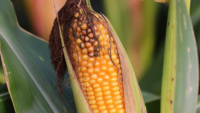Risk of Aflatoxin Grows for U.S. Corn

A recent study published in the journal Environmental Research Letters suggests that aflatoxin will become increasingly prevalent in U.S. corn production due to the effects of climate change. Based on the results of 16 climate change models, over 89.5 percent of corn-growing countries in 15 states may experience heightened aflatoxin contamination in 2031–2040, compared to 2011–2020.
Aflatoxin contamination of corn is caused by the fungi Aspergillus flavus and Aspergillus parasiticus. Hot and dry conditions encourage fungi spores to be airborne, which allows for the contamination of crops.
Due to different regional climates in the U.S., aflatoxin perennially affects corn grown in the South, but is not common in the Midwest Corn Belt or northern states. However, the study suggests that future increases of aflatoxin will be a cause for concern more in the Corn Belt and northern states than in southern states, as aflatoxin-causing fungi are inactivated at very high temperatures.
The study’s researchers state that the grain industry can mitigate the risk of aflatoxin contamination by storing corn harvests in cool, dry places and irrigating crops as much as possible. Researchers also suggest that crop production may have to move further north or south, where the climates are cooler or wetter, to reduce aflatoxin risk. This would pose a problem for generationally owned farms.
Looking for a reprint of this article?
From high-res PDFs to custom plaques, order your copy today!






